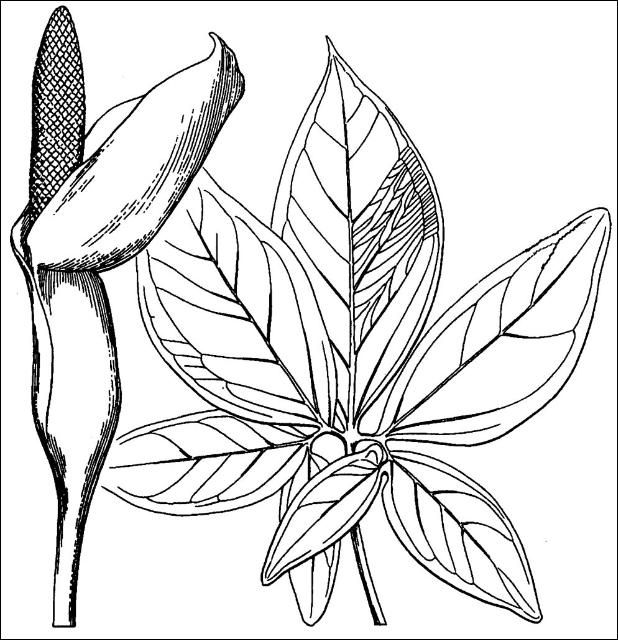Wildland Weeds: Arrowhead Vine, Syngonium podophyllum
Introduction
For years, people have come to south Florida to escape the cold weather and enjoy the subtropical climate. With this migration, horticulturists and amateur plant enthusiasts have introduced many species of exotic plants from the tropics, attempting to create their own tropical oases. While most of these plants either quickly perish or never spread outside of the backyard, a few escape and spread to adjoining natural and semi-disturbed areas and create persistent self-perpetuating populations. These plants are called invasive, and they can wreak havoc in the environments of their adopted home. Arrowhead vine (Syngonium podophyllum) is one of these destructive invaders.
Impacts
Arrowhead vine (Figure 1) is listed as a Category I invasive species by the Florida Exotic Pest Plant Council (FLEPPC 2003). By definition, exotic plants on this list alter native plant communities by displacing native species, changing community structures or ecological functions, or hybridizing with natives.

Credit: Mayo et al. (1995)
There are no native members of the genus Syngonium in Florida, which rules out hybridization as an impact, yet it is easy to see the effect the plant has upon native communities. Arrowhead vine is a strong climber, easily reaching the tops of our native trees. The stems by which it climbs are thick and fleshy giving them a weight much heavier than most native vines, thus potentially making trees top heavy and more susceptible to toppling in a strong wind. Recent work also has shown that arrowhead vine poses a threat to several endangered species of native ferns in Florida (Possley 2004).
In several areas of St. Lucie and Indian River counties, arrowhead vine has created a thick ground cover that is largely impenetrable to other plants (Morgan pers. obs.), and its extensive root system makes the plant extremely difficult to remove.
Arrowhead vine is currently most common in the southern third of peninsular Florida but was recently reported from as far north as Alachua County (Judd 2003). In St. Lucie county, where previously it had gone unreported, arrowhead vine has recently been found to be locally abundant (Morgan and Overholt 2005), leading to the possibility that this invader may be significantly more widespread than currently realized.
UF/IFAS Assessment
Arrowhead vine has been reviewed using the IFAS Assessment of Non-Native Plants in Florida's Natural Areas (UF/IFAS 2018), which provides a mechanism by which all UF/IFAS Extension publications conform in their description and categorization of non-native plants that are invading natural areas in Florida. The conclusions were that arrowhead vine is invasive and not recommended for use anywhere in the state. Arrowhead vine has known high ecological impacts in the southern and central zones and although it has not yet been found in undisturbed areas in the northern zone, it is thought to have the potential to cause ecological damage in the north as well. This species also is considered to have high potential for expansion in all areas of the state and high difficulty of management.
Identification
For those interested in monitoring and eradicating the plant, arrowhead vine is quite easy to identify. Seedlings of the plant (Figure 2) are quite common and have one to several simple, sagittate (arrowhead-shaped) leaves, within which there is high variation of coloration, many seedlings showing different levels of a white-green variegation.

Older plants have compound leaves which look different from those of the seedlings. They have 15–24 inch (15–60 cm) long petioles (leaf branches) and three to twelve leaflets of varying size, the larger ones towards the center (Figure 3). Leaflets are generally dark green above and pale green below and leaves and stem contain a milky sap.

Arrowhead vine has a typical araceous spadix and spathe type inflorescence (Figure 1), usually occurring in clusters of five to eight after the plant has matured and climbed a high into the tree canopy.
As with many plants in the horticultural trade, arrowhead vine goes by numerous common names including American evergreen, fivefingers, and nephthitis. Commonly available cultivars include "white butterfly" and "pink allusion".
What can you do?
If you have arrowhead vine growing on your land, it should be removed to keep it from spreading to natural areas. Hand pulling is possible but sprouts break easily and will re-sprout, so care must be taken so that they are completely removed. Plants which are discarded must be disposed of properly, ideally in sealed plastic garbage bags prior to transfer to an approved landfill. Some people keep arrowhead vine as a house plant, which poses little environmental threat. However, if house plants are trimmed or discarded, plants and plant parts must be properly disposed of in plastic bags. Note that gloves should be worn when removing arrowhead vine, as sap can be irritating to sensitive individuals.
Herbicides alone or in combination with hand pulling can be used to control arrowhead vine. Herbicide products with the active ingredient glyphosate (examples: Roundup Pro Concentrate, Glyphos, Glypro Plus, Touchdown Pro, Roundup Weed and Grass Killer Concentrate) or triclopyr (examples: Garlon 3A, Garlon 4, Brush-B-Gon, Brush Killer) are applied to the foliage and stems. Roundup Weed and Grass Killer Concentrate, Brush-B-Gon, and Brush Killer can be purchased from retail garden supply stores. (Langeland & Stocker 1997).
References
FLEPPC. 2019. 2019 List of Invasive Plant Species. (https://floridainvasivespecies.org/plantlist2019.cfm, Accessed 3/7/2022)
Judd, W.S. 2003. "New and noteworthy collections from Florida." Castanea 68:81–83.
Langeland, K.A. and R. Stocker. 1997. Control of Non-Native Plants in Natural Areas of Florida. SP242. Gainesville: University of Florida Institute of Food and Agricultural Sciences.
Mayo, S.J., J. Bogner, and P.C. Boyce. 1997. The genera of Araceae. Kew, Royal Botanic Gardens Press. 370pp.
Morgan, E.C. and W.A. Overholt. 2005. "New records of exotic invasive plant species in St. Lucie County, FL." Castanea 70:59–62.
Possley, J. 2004. "Exotic species threaten rare ferns in Miami-Dade county." Wildland Weeds 7:12–15.
University of Florida, Institute of Food and Agricultural Sciences. 2018. "Assessment of Non-native Plants in Florida's Natural Areas, " (https://assessment.ifas.ufl.edu/assessments/syngonium-podophyllum/, Accessed 6/25/2019) Gainesville, FL, 32611-4000.


